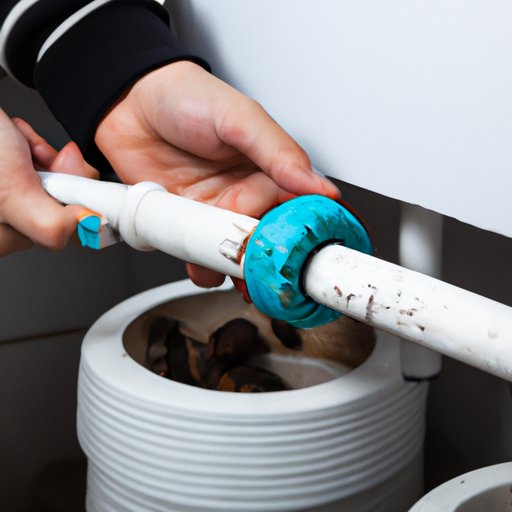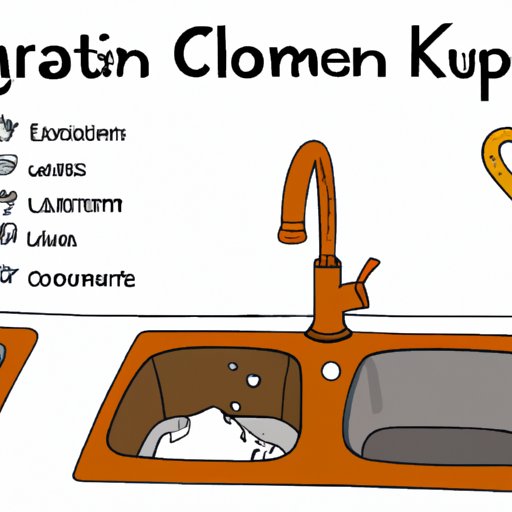
Introduction
Have you ever experienced the frustration of a clogged drain? Whether it’s a slow drain or one that’s completely blocked, it can be a major inconvenience. Not only does it disrupt your daily routine, but it can also lead to unpleasant odors and potential water damage. While calling a professional is always an option, many clogs can be resolved with simple DIY methods. In this article, we will explore various methods, tools, and tips for unclogging your drain.
10 Simple DIY Methods to Unclog Your Drain
There are several easy methods you can try before calling a plumber. Here are ten DIY methods you can use to unclog your drain:
Method 1: Boiling Water
One of the simplest methods to unclog a drain is to pour boiling water down it. Boil a pot of water and slowly pour it down the drain, letting it seep through. It’s important to note that this method works well for drains that are only partially clogged. If you have a completely blocked drain, it may not be very effective.
Method 2: Using a Plunger
A plunger is a useful tool for unclogging drains. It works by creating suction, which helps to push debris through the pipes. Place the plunger over the drain and push down, then pull back up again. Repeat this several times until the clog is cleared.
Method 3: Baking Soda and Vinegar
This method is a great natural alternative to harsh chemicals. Mix equal parts baking soda and vinegar and pour the mixture down the drain. Let it sit for 30 minutes, then flush with hot water. This combination creates a chemical reaction that can dissolve buildup and clear minor clogs.
Method 4: The Wire Hanger Trick
If you don’t have a plumbing snake on hand, you can use a wire hanger to unclog your drain. Straighten the hanger and bend one end to create a small hook. Insert the hooked end into the drain and gently twist and pull. This method can be effective for removing hair and other debris.
Method 5: Dish Soap and Hot Water
This method works best for grease clogs. Squirt a generous amount of dish soap into the drain, then pour hot water over it. The soap breaks down the grease, allowing it to be flushed away with hot water.
Method 6: Wet and Dry Vacuum
If you have a wet and dry vacuum, you can use it to suck out the clog. Set the vacuum to the wet setting and cover the vent with a cloth to create a seal. Place the end of the hose over the drain and turn on the vacuum. This can be an effective method for tough clogs.
Method 7: Caustic Soda
Caustic soda, also known as sodium hydroxide, is a powerful chemical that can dissolve tough clogs. However, it’s important to use caution when working with it, as it can be dangerous if not handled properly. Mix the caustic soda with water according to the package instructions, then pour it down the drain. Let it sit for a few hours, then flush it away with hot water.
Method 8: Plumbing Snake
A plumbing snake, also known as an auger, is a tool used to unclog drains. Insert the snake into the drain and turn the handle to push it through the pipes. The snake will grab onto the clog and allow you to pull it out.
Method 9: Bio-Enzymatic Cleaner
Bio-enzymatic cleaners are a natural alternative to harsh chemicals. These cleaners contain bacteria and enzymes that break down organic matter and eliminate odors. Pour the cleaner down the drain and let it sit for several hours, then flush with hot water.
Method 10: Hydro Jet
A hydro jet is a high-pressure water stream that can blast away tough clogs. This method is best left to the professionals, as it requires specialized equipment.
5 Tips for Unclogging Your Sink Naturally
In addition to the DIY methods outlined above, there are several things you can do to prevent clogs from happening in the first place. Here are five tips for keeping your sink drain clear and unclogged:
Tip 1: Do Not Pour Grease or Oil Down the Drain
Grease and oil can solidify in your pipes and cause major clogs. Instead of pouring it down the drain, dispose of grease and oil in the trash.
Tip 2: Use a Drain Strainer to Catch Hair and Larger Debris
A drain strainer is an inexpensive and effective way to prevent larger debris from going down the drain. It can catch hair, food particles, and other debris.
Tip 3: Rinse Your Sink with Hot Water Regularly
Running hot water down the drain on a regular basis can help to dissolve minor buildup and prevent clogs.
Tip 4: Use Natural Cleaning Products, Such as Lemon or Baking Soda
Natural cleaning products are a great alternative to harsh chemicals. Lemon and baking soda can be used to dissolve buildup and deodorize your drain.
Tip 5: Avoid Using Harsh Chemicals
Harsh chemicals can damage your pipes and harm the environment. Use natural alternatives whenever possible.
The Ultimate Guide to Unclogging Your Shower Drain
Shower drains can become clogged with hair and soap buildup. Here is a step-by-step guide on how to unclog your shower drain:
Step 1: Remove Visible Debris
Use a pair of needle-nose pliers to remove any visible debris from the drain.
Step 2: Pour Boiling Water Down the Drain
Boil a pot of water and slowly pour it down the drain.
Step 3: Use Baking Soda and Vinegar
Mix equal parts baking soda and vinegar and pour it down the drain. Let it sit for 30 minutes, then flush with hot water.
Step 4: Run a Plumbing Snake
If the clog is still present, use a plumbing snake to remove it.
Step 5: Hire a Professional
If all else fails, it’s time to call a professional plumber.
The Top 7 Tools to Unclog Any Drain
While many clogs can be resolved with simple DIY methods, there may be times when you need to use specialized tools. Here are the top seven tools you can use to unclog any drain:
Tool 1: Plunger
A plunger is a must-have for any homeowner. It’s a simple, yet effective tool for unclogging drains.
Tool 2: Drain Snake
A drain snake, also known as an auger, is a flexible metal cable that can be inserted into drains to remove clogs.
Tool 3: Plumbers’ Auger
A plumbers’ auger, also known as a toilet auger, is a specialized tool used for clearing clogs in toilets.
Tool 4: Wet and Dry Vacuum
A wet and dry vacuum can be used to suck out any debris that’s causing a clog.
Tool 5: Power Drill and Drum Auger
A power drill and drum auger is a motorized version of a drain snake. It’s a fast and effective way to clear tough clogs.
Tool 6: Hydro Jet
A hydro jet is a high-pressure water stream that can blast away even the toughest clogs.
Tool 7: Sewer Camera
A sewer camera is a tool used by plumbers to inspect the inside of pipes and locate clogs.

How to Unclog Your Kitchen Sink with Common Household Items
A clogged kitchen sink can be a major inconvenience. Here are five easy methods you can use to unclog your kitchen sink using common household items:
Method 1: Boiling Water
Boil a pot of water and pour it down the drain slowly.
Method 2: Baking Soda and Vinegar
Mix equal parts baking soda and vinegar and pour it down the drain. Let it sit for 30 minutes, then flush with hot water.
Method 3: Salt and Boiling Water
Mix a quarter cup of salt with boiling water and pour it down the drain.
Method 4: Ice Cubes and Salt
Place a few ice cubes and a tablespoon of salt down the drain. Let it sit for 10 minutes, then run hot water down the drain.
Method 5: Plunger
Use a plunger to create suction and push the clog through.
5 Do’s and Don’ts for Unclogging Your Toilet
Here are five things you should and should not do when unclogging your toilet:
Do 1: Use a Plunger
A plunger is the most effective tool for unclogging a toilet.
Do 2: Use Hot Water and Dish Soap
Squirt a generous amount of dish soap into the toilet, then pour hot water over it.
Do 3: Use a Plumbing Snake
If the plunger doesn’t work, a plumbing snake is the next step.
Do 4: Call a Professional Plumber If All Else Fails
If you’ve tried all of the DIY methods and the clog is still present, it’s time to call in a professional plumber.
Don’t 1: Use Bleach or Other Harsh Chemicals
Bleach and other harsh chemicals can damage your toilet and harm the environment.
Don’t 2: Pour Too Much Water Down the Drain
If the toilet is already clogged, pouring more water down will only make it worse.
Don’t 3: Use Non-Flushable Items in the Toilet
Non-flushable items, such as wipes and feminine hygiene products, can cause major clogs in your toilet.
The Most Common Causes of a Clogged Drain and How to Fix Them
Understanding the most common causes of clogs can help you prevent them from happening. Here are three common causes of clogs and how to fix them:
Cause 1: Hair and Soap Buildup
Solution: Use a drain strainer and clean the drain regularly.
Cause 2: Food and Grease Buildup in the Kitchen Sink
Solution: Do not pour grease or oil down the drain.
Cause 3: Foreign Objects Stuck in the Drain
Solution: Use a plumbing snake or call a professional.
Conclusion
As you can see, there are many ways to unclog a drain. With these DIY methods, natural tips, and specialized tools, you can tackle even the toughest clogs. Remember to always follow safety guidelines and use caution when working with chemicals and tools. Try these methods yourself before calling a professional, and you might just save yourself time and money.




